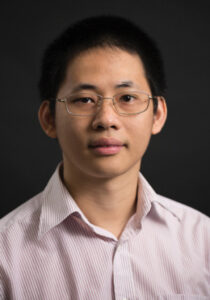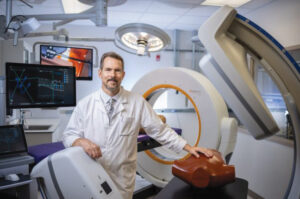Will AI Turn Cancer on its Head?


The media has often projected a doom-and-gloom scenario concerning AI and its capabilities to do harm. However, AI is changing how we are treated for many diseases, including cancer. We have recently seen giant leaps in the field of cancer treatments, most notably with immunotherapy. There is, however, a new frontier of machine learning and AI tools that will exceed our human capabilities.
Two area hospitals we asked about AI’s effects expressed optimism for better patient outcomes.
Houston Methodist has partnered with a large AI company to create tools that leverage their database; MD Anderson has created its own Institute for Data Science in Oncology (IDSO) to help ‘harness the power’ and accelerate the pace of their mission to end cancer.
Houston Methodist, by partnering with an established artificial intelligence company, was able to more quickly provide physicians and staff with predictive tools to identify at-risk patients better and improve long-term outcomes.
The partnership with the Health Data Analytics Institute (HDAI) leverages the company’s extensive database of Medicare data to generate personalized information about Houston Methodist patients.

In addition to this partnership, the University of Houston and Methodist Hospital have a grant to study using AI To identify breast cancer. Dr. Hien Van Nguyen, an Assistant Professor of Electrical and Computer Engineering at the University of Houston’s Cullen College of Engineering, received an R01 sub-award of $319,285 for his grant, “Convergent AI for Precise Breast Cancer Risk Assessment,” from the National Cancer Institute, National Institutes of Health. Breast cancer is one of the leading causes of death for women. However, A large percentage of breast biopsies, ranging, are found to be benign lesions. “We want to use multiple artificial intelligence tools, like image analysis and natural language processing, to process multi-modal data from collection methods like mammography, ultrasound, radiomics, and clinical features, to predict the breast lesion risk,” Nguyen explained.
The research will span over the next five years through May 2025. The multi-disciplinary team comprises artificial intelligence experts like Nguyen, computational disease management experts like Dr. Stephen Wong (John S. Dunn Senior Presidential Distinguished Chairman in Biomedical Engineering at Houston Methodist), and breast cancer expert Dr. Jenny Chang (the Director of Houston Methodist Cancer Center).
Reducing big data into actionable insights and harnessing the power of AI
The partnership with HDAI produces personalized risk profiles by matching real-time data from Houston Methodist patients with similar patients drawn from HDAI’s archive of electronic health records of more than 100 million patients over 20 years. The result is predictable logarithms for each patient’s anticipated mortality, length of stay, risk of developing a chronic condition or adverse event, and readmission possibility.
Dr. Alan Lumsden, chairman of cardiovascular surgery at Houston Methodist,
stressed AI’s powerful ability to transform massive amounts of cumbersome and sprawling data into actionable insights.
Houston Methodist focuses on the highest-risk quintile, the top 20% of at-risk patients because they generate most of the risk of readmissions and mortality. Dr. Lumsden said that allows the hospital to “focus our resources on where they’ll have the most impact.”
Dr. Lumsden acknowledged that AI’s greatest challenge in health and cancer care is acceptance—overcoming doctors’ passive resistance and changing the direction of an industry not known for moving quickly.
Realizing the power of data science to advance cancer research and cancer care

Currently, the standard of care is to follow a patient’s treatment protocol until imaging shows that a tumor has progressed and then adjust treatment. MD Anderson’s new IDSO programs aim to use a combination of biomarkers, such as tumor measurement and circulating tumor cells, to proactively anticipate if a patient won’t respond well to a treatment course. Using data-driven predictive approaches will improve patients’ outcomes. IDSO provides programs to create the next, and – in many cases – the first generation of data science being applied to the challenge of ending cancer.
MD Anderson’s Institute for Data Science in Oncology (IDSO) will harness the power of data and bring data science to decision-making. “IDSO is designed to bend the knee of data science for MD Anderson’s mission to end cancer,” says David Jaffray, Ph.D., director of IDSO, chief technology and digital officer, and senior vice president for MD Anderson.
The institute is designed to enable the full power of data science. Ultimately, this should advance drug discovery efforts, bring new, precise medicines to patients sooner, and reduce the time between diagnostic procedures and treatment decisions.
“We need to use next-generation computational technologies and approaches to aid what our minds alone can’t realize to reach potentials unknown,” says Jaffray. “The urgency to address the cancer problem is too great to continue with our traditional approaches.”
“This is a collective effort to maximize the availability of data with appropriate curation for learning through the next generation of data science methods. It’s aligned under our core value of Stewardship with our substantial research, clinical and operational teams, our emerging data management system, and our digital architecture teams collaborating closely,” says Caroline Chung, M.D., director of data science development and implementation for IDSO, chief data officer and vice president for Data Impact and Governance.
Teaming, recruiting and collaborating to advance data science
“Supported by our institutional commitment and investment in team data science, we are building and enhancing an unprecedented oncological data ecosystem to enable effective and impactful data collaborations with other world-leading organizations and data scientists from across many fields to bring novel perspectives to accelerate research and treatment innovation,” says Chung. “It will transition our approach from precision to predictive oncology.”
Currently, the standard of care is to follow a patient’s treatment protocol until imaging shows that a tumor has progressed and then adjust treatment. Through IDSO, the aim is to use a combination of biomarkers, such as tumor measurement and circulating tumor cells, to proactively anticipate if a patient won’t respond well to a treatment course.
IDSO is already enabling collaborations in data science and computational modeling discovery with The University of Texas at Austin Oden Institute for Computational Engineering and Sciences and the Texas Advanced Computing Center, Rice University and Break Through Cancer.
AI is used primarily in cancer care as a diagnostic tool—for detecting tumor cells on pathology slides and identifying tumors on X-rays and other radiology images. When new AI models are developed to assess a patient’s prognosis, there are concerns over who or what is legally responsible should an AI-recommended treatment harm a patient. These are some of the legal issues that will have to be addressed.
Advancing cancer surgery through data science

At MD Anderson, operating rooms treat thousands of patients each year. The cast will expand to include data scientists and engineers. Led by Jeff Siewerdsen, Ph. D., these quantitative scientists experience first-hand the operating room workflows they’re trying to improve.
MD Anderson’s Surgical Data Science Program was born from Siewerdsen’s observations over his 25 years as an academic researcher. In that time, he focused on developing new imaging technologies for diagnostic and interventional procedures. While his work produced numerous technologies and algorithms now used in operating rooms, he has strived more recently to conduct his research more closely with clinical teams impacted by the problems he has sought to address.
“Rather than continuing to add new technologies to address unmet clinical needs, I wanted to simplify, integrate, and critically evaluate the value of new technologies using data science and systems engineering,” says Siewerdsen.
That opportunity arrived last year when MD Anderson recruited him.
Drawing inspiration from his research and the “Surgineering” education program he created at his previous institution, Siewerdsen established and leads a focus area within the newly launched (IDSO).
One example is the creation of computational tools for improved operating room scheduling, which enhances the efficiency of operating room use. Streamlining clinical workflows leads to increased patient access and enhanced clinician wellness. Another example is using machine learning for real-time analysis and prediction to avoid surgical adverse events.
“In the years ahead, my goal is not only to help move the needle on safety and quality but also to prove the hypothesis that quantitative scientists integrated with clinical operations are key to realizing major advances in surgery,” says Siewerdsen.
Lindsey Garner with MD Anderson contributed to this article.























